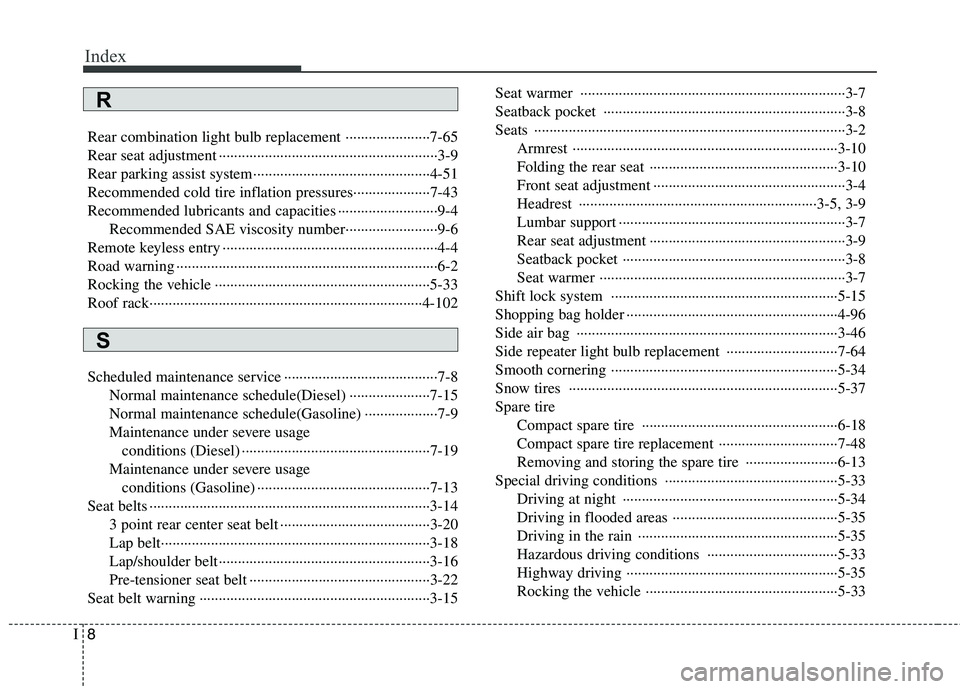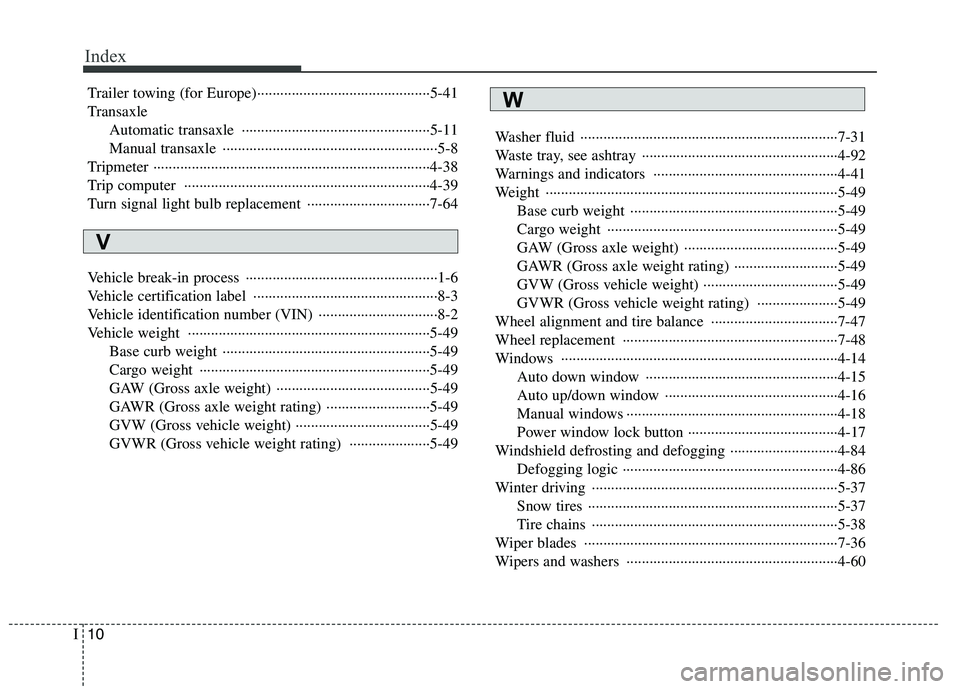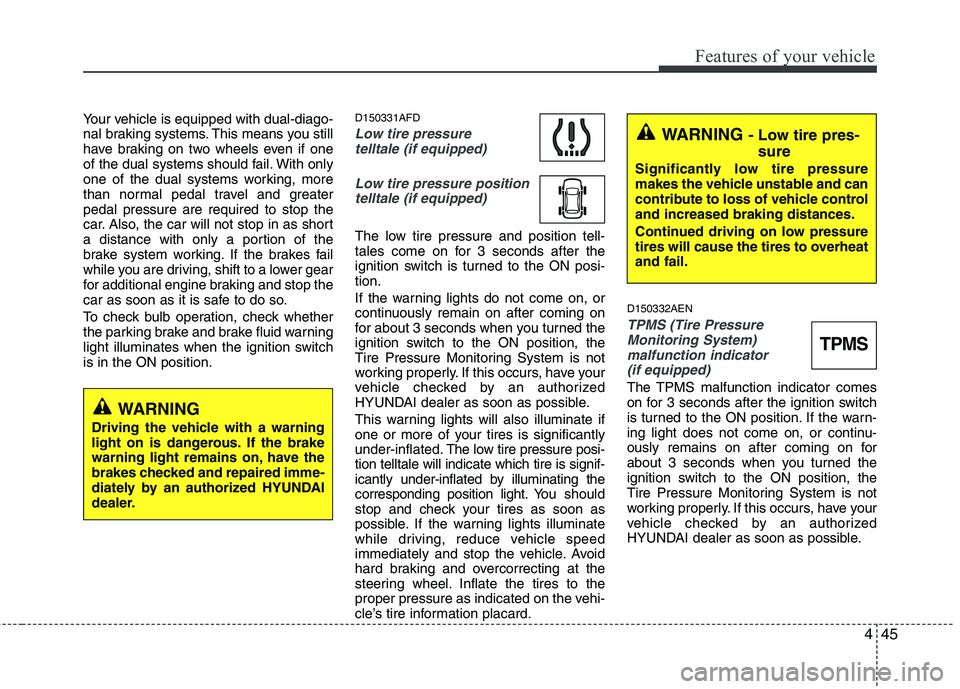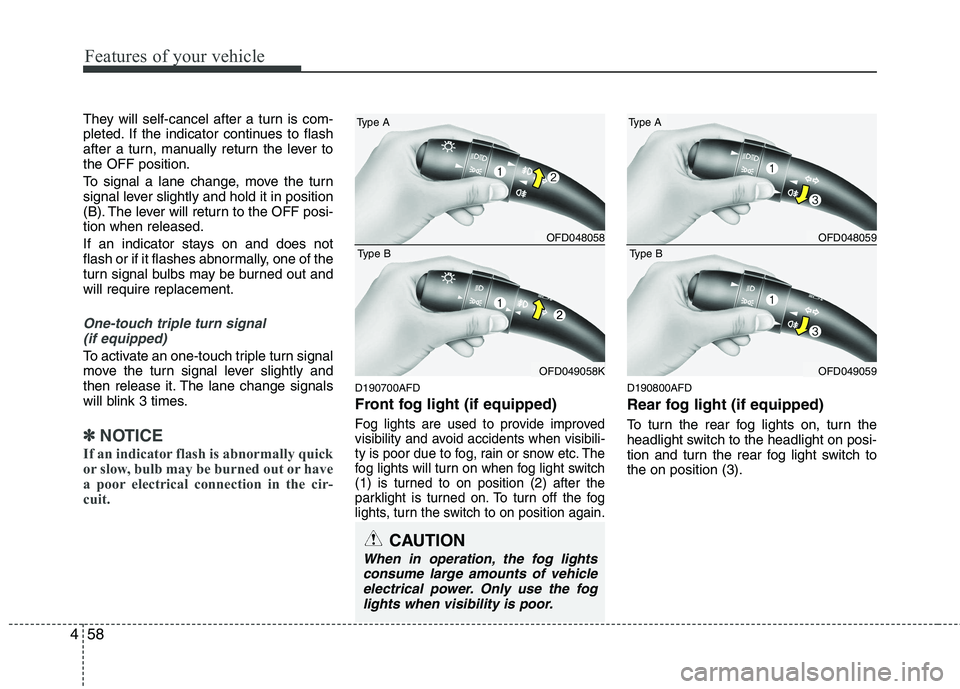2015 HYUNDAI I30 bulb
[x] Cancel search: bulbPage 411 of 635

Index
8
I
Rear combination light bulb replacement ······················7-65
Rear seat adjustment ·························································3-9
Rear parking assist system ··············································4-51Recommended cold tire inflation pressures····················7-43
Recommended lubricants and capacities ··························9-4
Recommended SAE viscosity number························9-6
Remote keyless entry ························································4-4
Road warning ····································································6-2
Rocking the vehicle ························································5-33
Roof rack·······································································4-102
Scheduled maintenance service ········································7-8 Normal maintenance schedule(Diesel) ·····················7-15
Normal maintenance schedule(Gasoline) ···················7-9
Maintenance under severe usage conditions (Diesel) ·················································7-19
Maintenance under severe usage conditions (Gasoline) ·············································7-13
Seat belts ·········································································3-14 3 point rear center seat belt ·······································3-20
Lap belt······································································3-18
Lap/shoulder belt·······················································3-16
Pre-tensioner seat belt ···············································3-22
Seat belt warning ····························································3-15 Seat warmer ·····································································3-7
Seatback pocket ·······························································3-8Seats ·················································································3-2
Armrest ·····································································3-10
Folding the rear seat ·················································3-10
Front seat adjustment ··················································3-4
Headrest ······························································3-5, 3-9
Lumbar support ···························································3-7
Rear seat adjustment ···················································3-9
Seatback pocket ··························································3-8
Seat warmer ································································3-7
Shift lock system ···························································5-15
Shopping bag holder ·······················································4-96
Side air bag ····································································3-46
Side repeater light bulb replacement ·····························7-64
Smooth cornering ···························································5-34
Snow tires ······································································5-37Spare tire Compact spare tire ···················································6-18
Compact spare tire replacement ·······························7-48
Removing and storing the spare tire ························6-13
Special driving conditions ·············································5-33 Driving at night ························································5-34
Driving in flooded areas ···········································5-35
Driving in the rain ····················································5-35
Hazardous driving conditions ··································5-33
Highway driving ·······················································5-35
Rocking the vehicle ··················································5-33
R
S
Page 413 of 635

Index
10
I
Trailer towing (for Europe)·············································5-41
Transaxle
Automatic transaxle ·················································5-11
Manual transaxle ························································5-8
Tripmeter ········································································4-38
Trip computer ································································4-39
Turn signal light bulb replacement ································7-64
Vehicle break-in process ··················································1-6
Vehicle certification label ················································8-3
Vehicle identification number (VIN) ·······························8-2
Vehicle weight ·······························································5-49 Base curb weight ······················································5-49
Cargo weight ····························································5-49
GAW (Gross axle weight) ········································5-49
GAWR (Gross axle weight rating) ···························5-49
GVW (Gross vehicle weight) ···································5-49
GVWR (Gross vehicle weight rating) ·····················5-49 Washer fluid ···································································7-31
Waste tray, see ashtray ···················································4-92
Warnings and indicators ················································4-41
Weight ············································································5-49
Base curb weight ······················································5-49
Cargo weight ····························································5-49
GAW (Gross axle weight) ········································5-49
GAWR (Gross axle weight rating) ···························5-49
GVW (Gross vehicle weight) ···································5-49
GVWR (Gross vehicle weight rating) ·····················5-49
Wheel alignment and tire balance ·································7-47
Wheel replacement ························································7-48
Windows ········································································4-14 Auto down window ··················································4-15
Auto up/down window ·············································4-16
Manual windows ·······················································4-18
Power window lock button ·······································4-17
Windshield defrosting and defogging ····························4-84 Defogging logic ························································4-86
Winter driving ································································5-37 Snow tires ·································································5-37
Tire chains ································································5-38
Wiper blades ··································································7-36
Wipers and washers ·······················································4-60
V
W
Page 517 of 635

445
Features of your vehicle
Your vehicle is equipped with dual-diago-
nal braking systems. This means you still
have braking on two wheels even if one
of the dual systems should fail. With only
one of the dual systems working, more
than normal pedal travel and greaterpedal pressure are required to stop the
car. Also, the car will not stop in as short
a distance with only a portion of the
brake system working. If the brakes fail
while you are driving, shift to a lower gear
for additional engine braking and stop the
car as soon as it is safe to do so.
To check bulb operation, check whether
the parking brake and brake fluid warning
light illuminates when the ignition switchis in the ON position.D150331AFDLow tire pressure
telltale (if equipped)
Low tire pressure positiontelltale (if equipped)
The low tire pressure and position tell-
tales come on for 3 seconds after the
ignition switch is turned to the ON posi-tion.
If the warning lights do not come on, or
continuously remain on after coming on
for about 3 seconds when you turned the
ignition switch to the ON position, the
Tire Pressure Monitoring System is not
working properly. If this occurs, have your
vehicle checked by an authorized
HYUNDAI dealer as soon as possible.
This warning lights will also illuminate if
one or more of your tires is significantlyunder-inflated. The low tire pressure posi-
tion telltale will indicate which tire is signif-
icantly under-inflated by illuminating the
corresponding position light. You should
stop and check your tires as soon as
possible. If the warning lights illuminate
while driving, reduce vehicle speed
immediately and stop the vehicle. Avoid
hard braking and overcorrecting at the
steering wheel. Inflate the tires to the
proper pressure as indicated on the vehi-
cle’s tire information placard. D150332AEN
TPMS (Tire Pressure
Monitoring System)
malfunction indicator (if equipped)
The TPMS malfunction indicator comes
on for 3 seconds after the ignition switch
is turned to the ON position. If the warn-
ing light does not come on, or continu-
ously remains on after coming on for
about 3 seconds when you turned the
ignition switch to the ON position, the
Tire Pressure Monitoring System is not
working properly. If this occurs, have your
vehicle checked by an authorized
HYUNDAI dealer as soon as possible.
WARNING
Driving the vehicle with a warning
light on is dangerous. If the brake
warning light remains on, have the
brakes checked and repaired imme-
diately by an authorized HYUNDAI
dealer.
WARNING - Low tire pres-
sure
Significantly low tire pressure
makes the vehicle unstable and can
contribute to loss of vehicle controland increased braking distances.
Continued driving on low pressure
tires will cause the tires to overheatand fail.
TPMS
Page 530 of 635

Features of your vehicle
58
4
They will self-cancel after a turn is com-
pleted. If the indicator continues to flash
after a turn, manually return the lever tothe OFF position.
To signal a lane change, move the turn
signal lever slightly and hold it in position
(B). The lever will return to the OFF posi-tion when released.
If an indicator stays on and does not
flash or if it flashes abnormally, one of the
turn signal bulbs may be burned out andwill require replacement.
One-touch triple turn signal
(if equipped)
To activate an one-touch triple turn signal
move the turn signal lever slightly and
then release it. The lane change signals
will blink 3 times.
✽✽ NOTICE
If an indicator flash is abnormally quick
or slow, bulb may be burned out or have
a poor electrical connection in the cir-
cuit.
D190700AFD
Front fog light (if equipped)
Fog lights are used to provide improved
visibility and avoid accidents when visibili-
ty is poor due to fog, rain or snow etc. The
fog lights will turn on when fog light switch
(1) is turned to on position (2) after the
parklight is turned on. To turn off the fog
lights, turn the switch to on position again.
D190800AFD
Rear fog light (if equipped)
To turn the rear fog lights on, turn the
headlight switch to the headlight on posi-
tion and turn the rear fog light switch tothe on position (3).
CAUTION
When in operation, the fog lights consume large amounts of vehicleelectrical power. Only use the foglights when visibility is poor.
OFD048058
Type A
OFD049058K
Type B
OFD048059
Type A
OFD049059
Type B